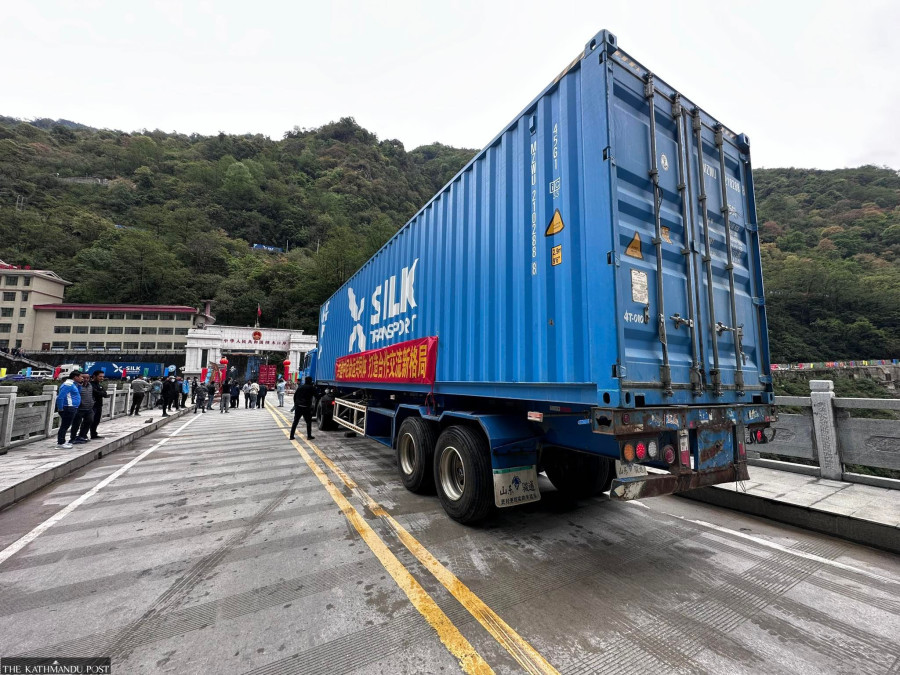Money
Two-way trade through Tatopani remains a mirage
Nepali traders say they are not allowed to sell their goods in Chinese cities even though the border has been reopened.
Anish Tiwari
Beijing supposedly reopened the Tatopani-Khasa route on the Nepal-China border to two-way trade last May, but Nepali traders say they were given false assurances.
“It’s only one-way trade,” said Sanu Maya Sherpa, a local trader from Bhotekoshi Rural Municipality-2. “We are not allowed to sell our products in Chinese cities.”
The northern border was closed after the 2015 earthquake. Commerce resumed through the Tatopani border point on May 1, and travel movement resumed on September 1.
But, according to traders, all is not as it seems.
Imports through the customs point have been rising by the day, but exports are almost zero. Local vegetables, fruits and other goods are not permitted to enter China.
“The Chinese government’s policy is to allow only its products to pass into Nepal but not to allow our goods in their market,” said Sherpa. “We are surprised by the decision of the northern neighbour. This won’t help Nepal’s trade in the long term.”
Sherpa also said that Chinese security personnel at Miteri Bridge marking the border have been causing hassles to Nepalis who go to buy household goods in the Chinese market.
Before the 2015 earthquake, 182 items such as handicrafts, medicinal herbs, noodles and other products were shipped to Chinese markets such as Khasa, Lhasa and Shigatse.
Hundreds of traders made their living from the export of locally produced goods.
Dayananda KC, chief of the Tatopani Customs Office, says the Chinese government has almost halted exports from Nepal.
On May 1, seven containers of bamboo stools, mattresses and chairs worth around Rs4.3 million were sent to China.
Before the April 2015 earthquakes, Nepal’s exports to China were booming. Nepal used to dispatch handicrafts, herbs, noodles and hundreds of other goods to Khasa, Shigatse and Lhasa in Tibet.
“There has been no export since then,” said KC. “Initially, around seven containers of goods used to enter Nepal daily. Now, the number has increased to 10 containers a day.”
The Tatopani Customs Office has set a target to collect Rs4.80 billion in revenue in the current fiscal year. So far, due to the rise in imports, revenue collection has already reached Rs1.80 billion, the customs office said.
Since the border was reopened to travellers, around 40 Chinese visitors have been entering Nepal daily. More than 200 Nepalis cross the border daily for shopping in the Chinese market.
Tatopani has bustled as a transit point from ancient times. Porters brought merchandise from Kathmandu which was transferred to mule caravans and transported over the Himalayan passes to various points in Tibet.
After the 2015 earthquake turned the border point into rubble, Tatopani and nearby places like Liping Bazaar became deserted.
On the Chinese side, the damaged infrastructure was rebuilt quickly. But little work has been done on the Nepal side.
Apart from Miteri Bridge and Tatopani dry port built by a Chinese company, all other essential structures like immigration and security posts on the Nepal side are in a dilapidated condition.
The final 26-km stretch of Araniko Highway to the border is yet to be repaired, and traders say it is dangerous to drive goods-laden containers over it.
Prime Minister Pushpa Kamal Dahal had asked the Chinese government to reconstruct and upgrade Araniko Highway during his visit to China.
Local representatives doubt there will be any improvement given the track record.
Several years ago, the China Railway Construction Bureau Group had upgraded and blacktopped the highway twice.
According to the Road Division in Charikot, Dolakha, around Rs1.36 billion was spent to upgrade the highway.
Traders are suffering because of the poor road condition as their cost of imports increases.
"As there is a possibility that the passage of 20-footer Chinese containers may damage the highway, the imported goods are unloaded at the dry port in Larcha and transferred to smaller containers for transport to Kathmandu," said Ramesh Neupane, chief district officer of Sindhupalchok.
Tatopani lies some 115 km northeast of Kathmandu on the Nepal-China border. It is the starting point of the legendary caravan route to Lhasa, and has been the main land route for trade with China since a highway linking Kathmandu opened in 1967.
China is the second largest trading partner of Nepal. In the last fiscal year 2022-23, Nepal’s exports to China stood at Rs1.76 billion. During the same period, imports from China totalled Rs222.71 billion.
Nepal's trade deficit with China was Rs220.95 billion in the last fiscal year, according to the Department of Customs.
Before Covid in fiscal 2018-19, imports amounted to Rs205.51 billion. In 2017-18, imports were valued at Rs159.98 billion, up from Rs129.87 billion in fiscal 2016-17.




 17.12°C Kathmandu
17.12°C Kathmandu















